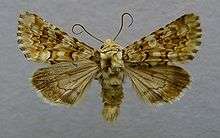Hadena irregularis
The Viper's Bugloss (Hadena irregularis) is a species of moth of the family Noctuidae. It is found in Europe.
| Hadena irregularis | |
|---|---|
 | |
| Scientific classification | |
| Kingdom: | |
| Phylum: | |
| Subphylum: | |
| Class: | |
| Order: | |
| Family: | |
| Genus: | |
| Species: | H. irregularis |
| Binomial name | |
| Hadena irregularis Hufnagel, 1766 | |
The wingspan is 32–36 mm.Meyrick describes it - Forewings whitish-ochreous, irregularly suffused with pale ochreous brownish ; first and second lines edged externally with ochreous brownish, internally with dark brown ; median line ochreous brown ; orbicular and reniform outlined with pale ; subterminal line pale, edged anteriorly with ochreous-brown ; termen unmarked; cilia barred. Hindwings light fuscous, with darker postmedian line and subterminal band.[1]
The moth flies from July to August depending on the location.
The larvae feed on Silene otites (in the seed-capsules) and Gypsophila species.
In 1998 the United Kingdom government removed Hadena irregularis from schedule 5 (animals) of the Wildlife and Countryside Act, 1981 as it is believed to be extinct. The cause of extinction has been hypothesised to be destruction of habitat, primarily the food source, which in the United Kingdom was limited to Spanish catch-fly (Silene otites).
References
- Meyrick, E., 1895 A Handbook of British Lepidoptera MacMillan, London pdf
